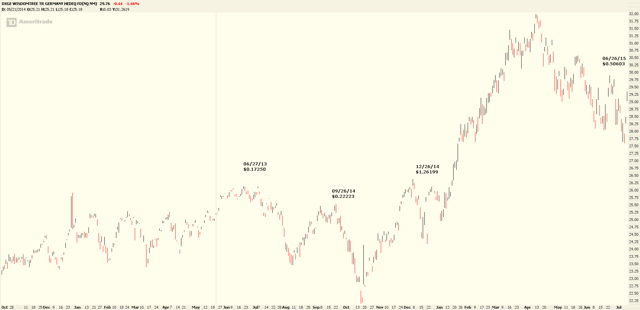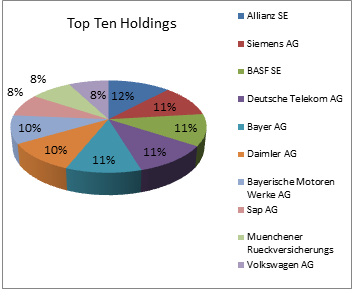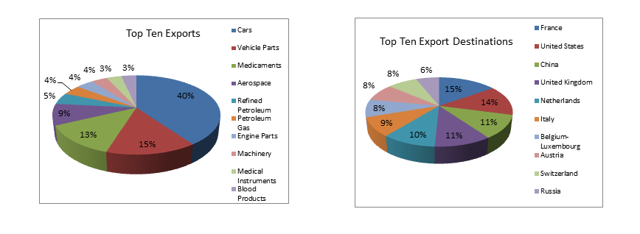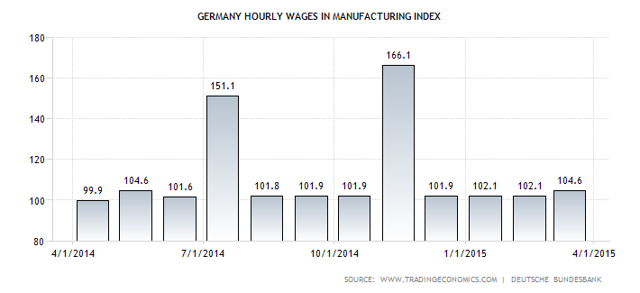Scalper1 News





 DXGE is a relatively new fund with solid returns since its inception. DXGE is weighted towards cyclicals in the best performing EU economy. The fund utilizes a U.S. Dollar hedge to protect against Euro volatility. There are several good ways to invest in Europe through individual country ETFs or by NYSE-ARCA listed European companies. One recent listing is the WisdomTree’s Germany Hedged Equity ETF (NASDAQ: DXGE ) . The German economy is, by far, the best performing industrial EU economy. The Euro has been weakened by extraordinary quantitative easing and by the continuing Greek debt impasse. A weak Euro benefits the German export economy greatly; however, currency volatility can work against an economy, too. Even hedging a portfolio will not eliminate currency risks entirely, but properly managed it will dampen volatility. In particular, it might ‘buy a little time’ for the investor to react should currency volatility suddenly work against a portfolio. According to WisdomTree: The Index and the Fund are designed to provide exposure to equity securities in Germany, while at the same time hedging exposure to fluctuations between the value of the U.S. dollar and the Euro . Germany has a $3.6 trillion dollar economy, 6th largest by World Bank GDP purchasing power parity calculations, with 2015 estimated 1.8% annualized growth and 15th per capita PPP-GDP at $44,469.00. According to the Deutsche Bundesbank Monthly Report , the economy grew 0.3% in the first quarter, down from the previous quarter’s reading of 0.7% but rebounded in the second quarter: … The German economy has recovered more quickly than expected from the cyclical lull in the middle of last year… …Bundesbank economists write that the economy has returned to a growth path underpinned by domestic and foreign demand… …Although foreign trade is currently being hampered by dampening global dynamics, it is simultaneously being buoyed by the euro’s depreciation and the strengthening economic recovery in the euro area. …In this setting, Bundesbank economists estimate that growth of 1.7% in Germany’s real gross domestic product (GDP) this year could be followed by a rise of 1.8% in 2016 and 1.5% in 2017. In calendar-adjusted terms, this would be equivalent to expansion rates of 1.5% in 2015 and 1.7% in both 2016 and 2017… In other words, in spite of all the issues in Europe and Asia, the German economy is still expected to grow. (click to enlarge) The top ten holdings should give the investor a good grasp of Germany’s global corporate dynamic. Of the fund’s top ten holdings 15.959% are automotive companies . The largest holding is Daimler AG ( OTCPK:DDAIY ) at 6.4195%; Daimler has 279,972 employees in production facilities in Europe, North and South America, Asia and Africa. Bayerische Motoren Werke ( OTCPK:BAMXY ) follows at 5.47505% of the top holdings; BMW employs over 100,000 in 14 countries. Lastly is Volkswagen ( OTCQX:VLKAY ), at 4.06418% of the top weighted companies, with 592,586 employees in 31 countries. (Data from WisdomTree) Financials comprise two of the top ten holdings accounting for 18.825%. Allianz ( OTCQX:AZSEY ) is a global financial services company, employing 147,000 in over 70 countries; accounting for 5.96224% of the fund. Muenchener Rueckversicherungs ( OTCPK:MURGY ), at 4.06405%, promotes itself as a global ‘one stop’ primary and re-insurer with 43,000 employs world-wide. Industrials have two companies in the top ten holdings. BASF ( OTCPK:BFFAF ), at 5.11571%, is a diversified manufacturer of both industrial and consumer products with 112,000 employees globally. Siemens ( SIE ), 5.10539%, manufactures industrial equipment, provides financial solutions for industrial customers and also has a consumer products division. Siemens employs over 343,000 in 300 countries. Industrials account for 19.191% of the top ten holdings. There’s an important point to be made here. Since a large portion of manufacturing and services are located outside of Germany, it’s reasonable to assume that if cost reductions are necessary they will be spread out globally. Thus work force reductions, if needed, can be widely distributed, minimizing the impact on local economies. The most telling statistics are the weightings which favor an expanding economy. Cyclicals such as Consumer Discretionary, Financials and Materials, account for a combined 51.42%. Cyclically sensitive sectors such as Telecom Services, IT, and Industrials, account for a combined 28.31%. Lastly, defensive holdings such as Consumer Staples, Utilities and Health Care, account for a combined 20.27%. In total, over 75% of the most heavily weighted holdings are cyclicals or semi-cyclical. Germany’s largest exports are: Autos at 11.22% of all exports; Vehicle Parts, 4.12%; Medicaments, 3.64% and Aerospace, 2.44%. It should also be noted that Engine Parts are 7th at 1.09%; Delivery Trucks, 12th at 0.90% and Transmissions, 13th at 0.87% of all exports. This is indicative of final auto assembly completed outside of Germany. Among the top export partners are: France at 8.81%; United States, 8.14%; China, 6.35%; United Kingdom, 6.21% and Netherlands, 5.84%. (click to enlarge) (Data from OEC) Of those top ten export destination, two present a serious problem. First is the continuing conflict in Ukraine, for which Germany is the leading moderator for a resolution. Russia’s top imports from Germany are automobiles, vehicle parts and machinery. Next is China which has been experiencing slowing growth. China imports automobiles, vehicle parts, aerospace products and machinery. Combined, Russia and China account for 18% of German industrial exports. (click to enlarge) The German export economy has an advantage by the weak Euro. Hence, German companies should reflect quarter over quarter earnings growth which in turn should reflect in equity market gains. Also job and wage growth, consumer spending and other domestic metrics should fare better than the EU as a whole in an uneven global economic environment. (click to enlarge) The fund holds $405,900,000 of assets in 78 equity holdings, as well as a short-long currency forward contract hedge. The ETF itself has 13,550,000 shares outstanding with a recent market price of 29.52 and a Net Asset Value of $29.96, thus trading at a discount to the NAV of about 1.49%. The average daily trading volume is approximately 140,487 shares. There are two competing currency hedged funds; three have nearly equal positive one year returns, one of which is the WisdomTree Fund. Three others have negative year returns. The table below compares the annualized returns of the Deutsche X-trackers MSCI Germany Hedged Equity ETF (NYSEARCA: DBGR ) and the iShares Currency Hedged MSCI Germany ETF (NYSEARCA: HEWG ). Note that WisdomTree uses its own underlying Germany Hedged Equity Index , while the X-Tracker and iShares utilize the MSCI Germany Hedged Index Fund (Mkt) 1 Month 3 Months Year to Date 1 Year 3 Year WisdomTree DXGE -3.55% -7.67% 15.86% 9.81% Incepted 10/17/13 X-Trackers DBGR -3.74% -8.21% 12.19% 10.36% 12.40% iShares HEWG -4.22% -8.58% 10.88 9.89 Incepted 1/31/14 In conclusion, this is a well-constructed single country focused fund, hedged against Euro weakness, with particularly good potential while the weak Euro gives its exports a price advantage. Disclosure: I/we have no positions in any stocks mentioned, and no plans to initiate any positions within the next 72 hours. (More…) I wrote this article myself, and it expresses my own opinions. I am not receiving compensation for it (other than from Seeking Alpha). I have no business relationship with any company whose stock is mentioned in this article. Additional disclosure: CFDs, spreadbetting and FX can result in losses exceeding your initial deposit. They are not suitable for everyone, so please ensure you understand the risks. Seek independent financial advice if necessary. Nothing in this article should be considered a personal recommendation. It does not account for your personal circumstances or appetite for risk. Scalper1 News
DXGE is a relatively new fund with solid returns since its inception. DXGE is weighted towards cyclicals in the best performing EU economy. The fund utilizes a U.S. Dollar hedge to protect against Euro volatility. There are several good ways to invest in Europe through individual country ETFs or by NYSE-ARCA listed European companies. One recent listing is the WisdomTree’s Germany Hedged Equity ETF (NASDAQ: DXGE ) . The German economy is, by far, the best performing industrial EU economy. The Euro has been weakened by extraordinary quantitative easing and by the continuing Greek debt impasse. A weak Euro benefits the German export economy greatly; however, currency volatility can work against an economy, too. Even hedging a portfolio will not eliminate currency risks entirely, but properly managed it will dampen volatility. In particular, it might ‘buy a little time’ for the investor to react should currency volatility suddenly work against a portfolio. According to WisdomTree: The Index and the Fund are designed to provide exposure to equity securities in Germany, while at the same time hedging exposure to fluctuations between the value of the U.S. dollar and the Euro . Germany has a $3.6 trillion dollar economy, 6th largest by World Bank GDP purchasing power parity calculations, with 2015 estimated 1.8% annualized growth and 15th per capita PPP-GDP at $44,469.00. According to the Deutsche Bundesbank Monthly Report , the economy grew 0.3% in the first quarter, down from the previous quarter’s reading of 0.7% but rebounded in the second quarter: … The German economy has recovered more quickly than expected from the cyclical lull in the middle of last year… …Bundesbank economists write that the economy has returned to a growth path underpinned by domestic and foreign demand… …Although foreign trade is currently being hampered by dampening global dynamics, it is simultaneously being buoyed by the euro’s depreciation and the strengthening economic recovery in the euro area. …In this setting, Bundesbank economists estimate that growth of 1.7% in Germany’s real gross domestic product (GDP) this year could be followed by a rise of 1.8% in 2016 and 1.5% in 2017. In calendar-adjusted terms, this would be equivalent to expansion rates of 1.5% in 2015 and 1.7% in both 2016 and 2017… In other words, in spite of all the issues in Europe and Asia, the German economy is still expected to grow. (click to enlarge) The top ten holdings should give the investor a good grasp of Germany’s global corporate dynamic. Of the fund’s top ten holdings 15.959% are automotive companies . The largest holding is Daimler AG ( OTCPK:DDAIY ) at 6.4195%; Daimler has 279,972 employees in production facilities in Europe, North and South America, Asia and Africa. Bayerische Motoren Werke ( OTCPK:BAMXY ) follows at 5.47505% of the top holdings; BMW employs over 100,000 in 14 countries. Lastly is Volkswagen ( OTCQX:VLKAY ), at 4.06418% of the top weighted companies, with 592,586 employees in 31 countries. (Data from WisdomTree) Financials comprise two of the top ten holdings accounting for 18.825%. Allianz ( OTCQX:AZSEY ) is a global financial services company, employing 147,000 in over 70 countries; accounting for 5.96224% of the fund. Muenchener Rueckversicherungs ( OTCPK:MURGY ), at 4.06405%, promotes itself as a global ‘one stop’ primary and re-insurer with 43,000 employs world-wide. Industrials have two companies in the top ten holdings. BASF ( OTCPK:BFFAF ), at 5.11571%, is a diversified manufacturer of both industrial and consumer products with 112,000 employees globally. Siemens ( SIE ), 5.10539%, manufactures industrial equipment, provides financial solutions for industrial customers and also has a consumer products division. Siemens employs over 343,000 in 300 countries. Industrials account for 19.191% of the top ten holdings. There’s an important point to be made here. Since a large portion of manufacturing and services are located outside of Germany, it’s reasonable to assume that if cost reductions are necessary they will be spread out globally. Thus work force reductions, if needed, can be widely distributed, minimizing the impact on local economies. The most telling statistics are the weightings which favor an expanding economy. Cyclicals such as Consumer Discretionary, Financials and Materials, account for a combined 51.42%. Cyclically sensitive sectors such as Telecom Services, IT, and Industrials, account for a combined 28.31%. Lastly, defensive holdings such as Consumer Staples, Utilities and Health Care, account for a combined 20.27%. In total, over 75% of the most heavily weighted holdings are cyclicals or semi-cyclical. Germany’s largest exports are: Autos at 11.22% of all exports; Vehicle Parts, 4.12%; Medicaments, 3.64% and Aerospace, 2.44%. It should also be noted that Engine Parts are 7th at 1.09%; Delivery Trucks, 12th at 0.90% and Transmissions, 13th at 0.87% of all exports. This is indicative of final auto assembly completed outside of Germany. Among the top export partners are: France at 8.81%; United States, 8.14%; China, 6.35%; United Kingdom, 6.21% and Netherlands, 5.84%. (click to enlarge) (Data from OEC) Of those top ten export destination, two present a serious problem. First is the continuing conflict in Ukraine, for which Germany is the leading moderator for a resolution. Russia’s top imports from Germany are automobiles, vehicle parts and machinery. Next is China which has been experiencing slowing growth. China imports automobiles, vehicle parts, aerospace products and machinery. Combined, Russia and China account for 18% of German industrial exports. (click to enlarge) The German export economy has an advantage by the weak Euro. Hence, German companies should reflect quarter over quarter earnings growth which in turn should reflect in equity market gains. Also job and wage growth, consumer spending and other domestic metrics should fare better than the EU as a whole in an uneven global economic environment. (click to enlarge) The fund holds $405,900,000 of assets in 78 equity holdings, as well as a short-long currency forward contract hedge. The ETF itself has 13,550,000 shares outstanding with a recent market price of 29.52 and a Net Asset Value of $29.96, thus trading at a discount to the NAV of about 1.49%. The average daily trading volume is approximately 140,487 shares. There are two competing currency hedged funds; three have nearly equal positive one year returns, one of which is the WisdomTree Fund. Three others have negative year returns. The table below compares the annualized returns of the Deutsche X-trackers MSCI Germany Hedged Equity ETF (NYSEARCA: DBGR ) and the iShares Currency Hedged MSCI Germany ETF (NYSEARCA: HEWG ). Note that WisdomTree uses its own underlying Germany Hedged Equity Index , while the X-Tracker and iShares utilize the MSCI Germany Hedged Index Fund (Mkt) 1 Month 3 Months Year to Date 1 Year 3 Year WisdomTree DXGE -3.55% -7.67% 15.86% 9.81% Incepted 10/17/13 X-Trackers DBGR -3.74% -8.21% 12.19% 10.36% 12.40% iShares HEWG -4.22% -8.58% 10.88 9.89 Incepted 1/31/14 In conclusion, this is a well-constructed single country focused fund, hedged against Euro weakness, with particularly good potential while the weak Euro gives its exports a price advantage. Disclosure: I/we have no positions in any stocks mentioned, and no plans to initiate any positions within the next 72 hours. (More…) I wrote this article myself, and it expresses my own opinions. I am not receiving compensation for it (other than from Seeking Alpha). I have no business relationship with any company whose stock is mentioned in this article. Additional disclosure: CFDs, spreadbetting and FX can result in losses exceeding your initial deposit. They are not suitable for everyone, so please ensure you understand the risks. Seek independent financial advice if necessary. Nothing in this article should be considered a personal recommendation. It does not account for your personal circumstances or appetite for risk. Scalper1 News
Scalper1 News